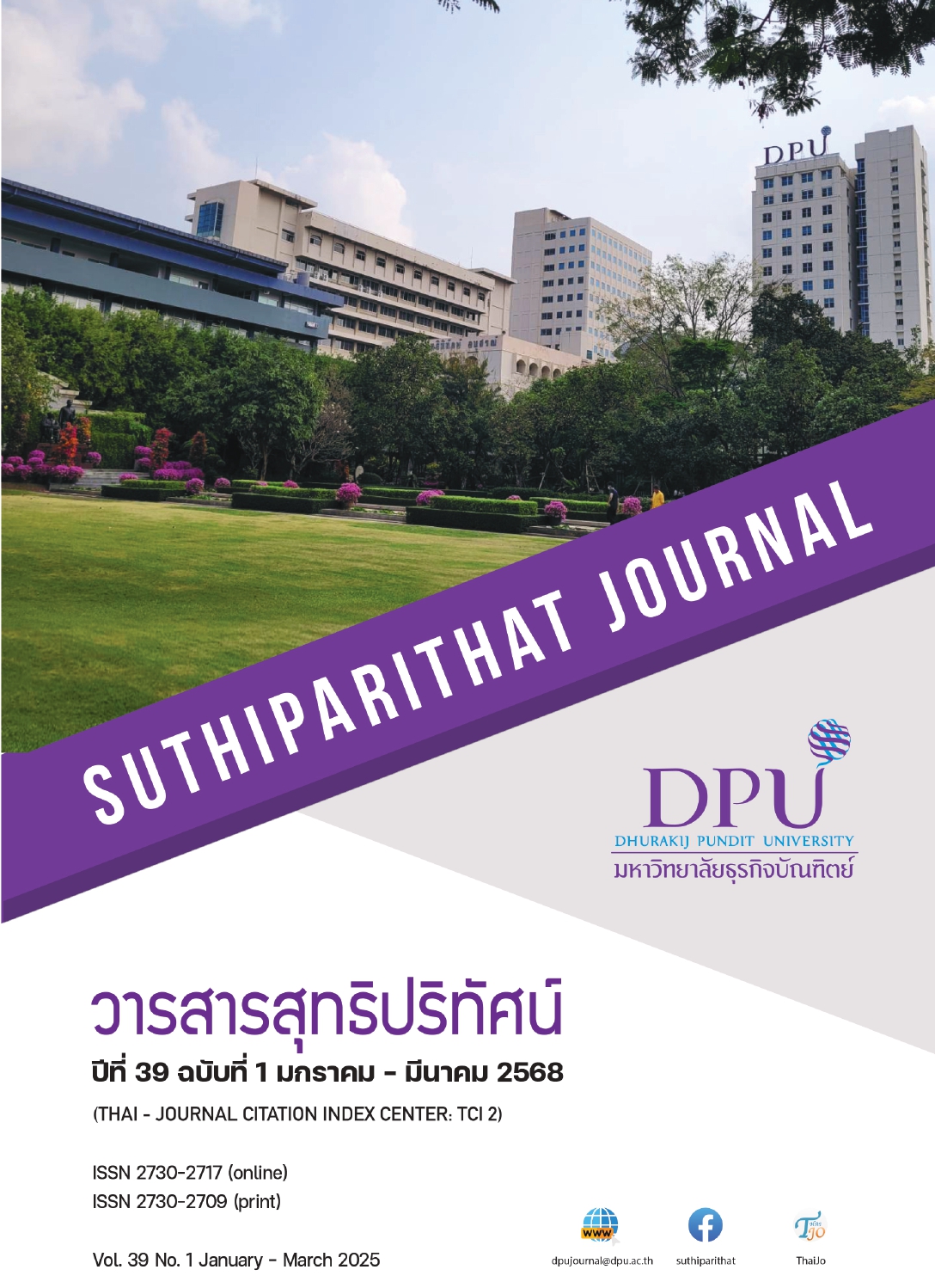อัตลักษณ์ทางสังคมมีอิทธิพลต่อแรงจูงใจของกลุ่มมิลเลนเนียลในการรับชมการถ่ายทอดสดออนไลน์
คำสำคัญ:
อัตลักษณ์ทางสังคม, แรงจูงใจในการรับชม, การถ่ายทอดสดออนไลน์, ผู้รับชมกลุ่มมิลเลนเนียลบทคัดย่อ
การศึกษานี้มีวัตถุประสงค์เพื่อศึกษาอิทธิพลของอัตลักษณ์ทางสังคมต่อแรงจูงใจของกลุ่มมิลเลนเนียลในการรับชมการถ่ายทอดสดออนไลน์ โดยเก็บข้อมูลผ่านแบบสอบถามที่แจกให้กลุ่มตัวอย่างจำนวน 360 คน ซึ่งเป็นมิลเลนเนียลที่เคยมีประสบการณ์รับชมการถ่ายทอดสดออนไลน์ การวิเคราะห์ข้อมูลใช้วิธีการวิเคราะห์การถดถอยพหุคูณ ผลการศึกษาสนับสนุนสมมติฐานที่ตั้งไว้ โดยระบุว่า อัตลักษณ์ทางสังคมมีผลต่อแรงจูงใจของกลุ่มมิลเลนเนียลในการรับชมการถ่ายทอดสดออนไลน์อย่างมีนัยสำคัญทางสถิติที่ระดับ 0.001 ตัวแปรอัตลักษณ์ทางสังคมที่ส่งผลต่อแรงจูงใจมากที่สุดคือ ความชื่นชอบในบุคคล (Beta = .456) รองลงมาคือ ความรู้สึกเป็นส่วนหนึ่งของกลุ่ม (Beta = .282) ทั้งสองตัวแปรมีผลในเชิงบวกต่อแรงจูงใจในการรับชม โดยตัวแปรความชื่นชอบในบุคคลส่งผลมากที่สุด
ผลการศึกษานี้แสดงให้เห็นว่า อัตลักษณ์ทางสังคมในทุกมิติส่งผลต่อแรงจูงใจในการรับชมการถ่ายทอดสดออนไลน์ โดยตัวแปรความชื่นชอบในบุคคลได้รับการประเมินว่าเป็นปัจจัยที่ส่งผลเชิงบวกมากที่สุด ความชื่นชอบในบุคคล หมายถึง ความเชื่อมโยงทางอารมณ์และความชื่นชมที่ผู้ชมมีต่อผู้ถ่ายทอดสด ซึ่งมีผลอย่างมากต่อแรงจูงใจของผู้ชมกลุ่มมิลเลนเนียลมีแนวโน้มที่จะดึงดูดผู้ถ่ายทอดสดที่ดูมีความเป็นตัวของตัวเอง น่าเชื่อถือ และมีความสามารถในการมีปฏิสัมพันธ์ ผลลัพธ์นี้ก่อให้เกิดความไว้วางใจและความภักดี ทำให้ผู้ชมติดตามและมีปฏิสัมพันธ์กับผู้ถ่ายทอดสดอย่างต่อเนื่อง
References
Cochran, W. G. (1977). Sampling techniques (3rd ed.). John Wiley & Sons.
Dholakia, U. M., Bagozzi, R. P., & Pearo, L. K. (2004). A social influence model of consumer participation in network- and small-group-based virtual communities. International Journal of Research in Marketing, 21(3), 241-263. https://doi.org/10.1016/j.ijresmar.2003.12.004
Dimock, M. (2019, January 17). Defining generations: Where millennials end and generation Z begins. Pew Research Center. https://www.pewresearch.org/short-reads/2019/01/17/where-millennials-end-and-generation-z-begins
Hamilton, W. A., Garretson, O., & Kerne, A. (2014). Streaming on twitch: Fostering participatory communities of play within live mixed media. In Proceedings of the SIGCHI conference on human factors in computing systems (pp. 1315-1324). https://doi.org/10.1145/2556288.2557048
Haslam, S. A., Reicher, S. D., & Platow, M. J. (2020). The new psychology of leadership: Identity, influence, and power (2nd ed.). Routledge. https://doi.org/10.4324/9781351108232
Helal, G., & Ozuem, W. (2019). Social media and social identity in the millennial generation. In Leveraging computer-mediated marketing environments (pp. 43-82). Business Science Reference. https://doi.org/10.4018/978-1-5225-7344-9.ch003
Rubin, A. M. (2009). Uses-and-gratifications perspective on media effects. In J. Bryant & M. B. Oliver (Eds.), Media effects: Advances in theory and research (pp. 165–184). Taylor & Francis.
Rubin, A. M., & Step, M. M. (2000). Impact of motivation, attraction, and parasocial interaction on talk radio listening. Journal of Broadcasting & Electronic Media, 44(4), 635-654. https://doi.org/10.1207/s15506878jobem4404_7
Sjöblom, M., Törhönen, M., Hamari, J., & Macey, J. (2017). Content structure is king: An empirical study on gratifications, game genres, and content types on Twitch. Computers in Human Behavior, 73, 161-171. https://doi.org/10.1016/j.chb.2017.03.036
Sunthornthai, W. (2008). The rationale behind the development of a 5-level decision-making criterion. Journal of Administrators, 28(3), 97–101. https://www.bu.ac.th/knowledgecenter/executivejournal/july_sep_08/july_sep_08.html
Tajfel, H., & Turner, J. C. (1979). An integrative theory of intergroup conflict. In W. G. Austin & S. Worchel (Eds.), The social psychology of intergroup relations (pp. 33–47). Brooks/Cole.
Wang, X., & Wu, D. (2019). Understanding user engagement mechanisms on a live streaming platform. In FH. Nah, & K. Siau, (Eds), HCI in business, government and organizations. Information systems and analytics. HCII 2019. Lecture Notes in Computer Science, vol 11589. Springer. https://doi.org/10.1007/978-3-030-22338-0_22
Wohn, D. Y., Freeman, G., & McLaughlin, C. (2015). Explaining viewers’ emotional, instrumental, and financial support of live streamers. Proceedings of the 2018 CHI conference on human factors in computing systems (pp. 1-13). https://dl.acm.org/doi/10.1145/3173574.3174048
Yu, E., Jung, C., Kim, H., & Jung, J. (2018). Impact of viewer engagement on gift-giving in live video streaming. Telematics and Informatics, 35(5), 1450-1460. https://doi.org/10.1016/j.tele.2018.03.014
กระทรวงดิจิทัลเพื่อเศรฐกิจและสังคม, สำนักงานสถิติแห่งชาติ. (2566). สำรวจการมีการใช้เทคโนโลยีสารสนเทศและการสื่อสารในสถานประกอบการ พ.ศ. 2565. ผู้แต่ง. https://www.nso.go.th/nsoweb/storage/survey_detail/2024/20231004084135_87842.pdf
Downloads
เผยแพร่แล้ว
How to Cite
ฉบับ
บท
License
Copyright (c) 2025 มหาวิทยาลัยธุรกิจบัณฑิตย์

This work is licensed under a Creative Commons Attribution-NonCommercial-NoDerivatives 4.0 International License.
เนื้อหาและข้อมูลในบทความที่ลงตีพิมพ์ในวารสารสุทธิปริทัศน์ ถือเป็นข้อคิดเห็นและความรับผิดชอบของผู้เขียนบทความโดยตรงซึ่งกองบรรณาธิการวารสาร ไม่จำเป็นต้องเห็นด้วย หรือร่วมรับผิดชอบใดๆ
บทความ ข้อมูล เนื้อหา รูปภาพ ฯลฯ ที่ได้รับการตีพิมพ์ในวารสารสุทธิปริทัศน์ ถือเป็นลิขสิทธิ์ของวารสารสุทธิปริทัศน์หากบุคคลหรือหน่วยงานใดต้องการนำทั้งหมดหรือส่วนหนึ่งส่วนใดไปเผยแพร่ต่อหรือเพื่อกระทำการใด ๆ จะต้องได้รับอนุญาตเป็นลายลักษณ์อักษรจากวารสารสุทธิปริทัศน์ก่อนเท่านั้น






